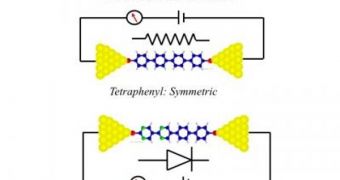Scientists from the Arizona State University (ASU) have recently managed to bring a significant contribution to creating future electronic devices, when they have made a new type of diode, barely the size of a molecule. The incredibly small device could be used in chips and processors in the near future, alongside other new materials such as graphene and gallium arsenide. In charge of the investigation has been N.J. Tao, an expert at the ASU Biodesign Institute, e! Science News reports.
Diodes are among the most ubiquitous components of the electronics world, and their sizes are among the determining factors in establishing those of a large array of devices. In a new study, published in the latest online issue of the respected scientific journal Nature Chemistry, the ASU team describe how they managed to create their tiny diode, which is roughly the size of a single molecule. Because of its reduced dimensions, the new gadget could be used in an emerging field of electronics, which aims at creating components able to operate at the nanoscale.
“Personally, I am interested in molecular electronics not because of their potential to duplicate today's silicon applications,” the expert says. The new class of electronic equipment that will become a reality within the next decade will feature significant differences from its predecessors and will be something completely new, not just an upgrade. Future components will have electronic, mechanical, optical and molecular properties that will far exceed those exhibited by electronics in circulation today, in terms of performance, reliability, sustainability, and so on.
“I think [the new study is] exciting because we are able to look at a single molecule and play with it. We can apply a voltage, a mechanical force, or optical field, measure current and see the response. As quantum physics controls the behaviors of single molecules, this capability allows us to study properties distinct from those of conventional devices,” the expert adds. “We are now able to do this – to build a single molecule device with a well defined orientation,” he concludes.

 14 DAY TRIAL //
14 DAY TRIAL //